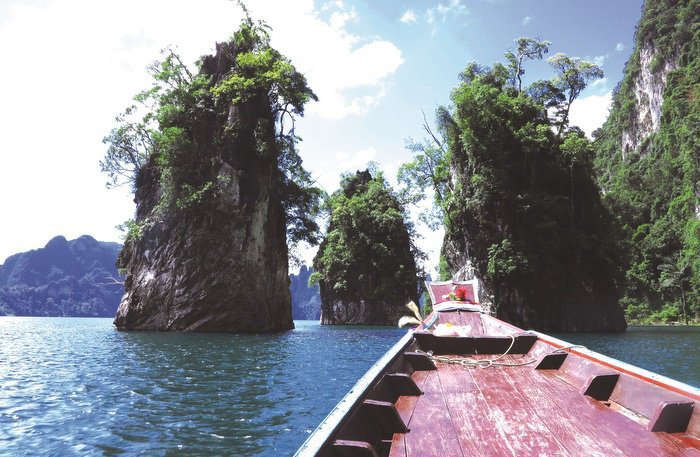Khao Sok diving ban maybe lifted

PHUKET: In a knee-jerk reaction, national park officers enforced a ban on all diving in the Chio Lan Reservoir, the center piece to the extraordinary Khao Sok National Park, following the death of two experienced cave divers in a diving accident on technical rebreathers last year (story here).
However, the ban might not last, Khao Sok National Park Chief Chaichana Wichaidit told the Phuket Gazette last week.
Within the diving industry, the deaths of Phuket divers Dmitry Dokuchave, 46, and fellow Russian national Alexander Solomatin are most often labeled as ‘diver error’, though it is still not known exactly what transpired about 20 meters below the surface of the lake last December. Nonetheless, their deaths directly led to the enforcement of a ban on all diving in the lake.
Despite the dive communities in the region regularly using the area, it has always been illegal, Mr Chaichana explained. However, the park chief has since put forward a proposal to the Department of National Parks, Wildlife and Plant Conservation (DNP) requesting six dive sites in the lake be opened to the general public.
Officers from Bangkok have already inspected the sites once, but have yet to give Mr Chaichana an indication of whether or not his request will be approved.
The sites were named as: Tham Long, Khlong Om, depth 25 meters; Khao Ta Chae, Khlong Long, depth 40m; in front of Pae Plern Prai, Khlong Long, depth 20m; Chom Plern Cliff, Khlong Long, depth 22m; Tham Khang Khao, Khlong Mon, depth 25m and Tham Klorng, Khlong Mon, depth 20m.
“They have to consider whether or not the diving is safe. Also, they have to ensure that the diving will not negatively affect the park’s natural resources,” Mr Chaichana explained.
The beauty of the Khao Sok, above and below the water, is indeed something to be cherished and preserved. The multitude of cave systems carved out of the karst topography of the looming limestone walls blanketed with jungle flora, as well as the dynamic underwater landscape, is exactly what has drawn divers to the man-made lake year after year.
“There are amazing stalactites and stalagmites in the caves, as they used to be dry caves. The whole experience: long tail boat, staying on the lake in the floating accommodation, waking up to the sounds of animals instead of traffic, great local people and great food all create an extraordinary experience for divers,” Simone Reynolds of Blue Label Diving explained.
Yet, perhaps like Phuket itself, it is not only the beauty of the location, but the accessibility that make the sites so important to dive companies in Phuket and essential to those in Khao Lak.
Those most affected by the closure were diving companies specializing in technical diving, perhaps about 15 in Thailand, as well as companies based in Khao Lak, as they are unable to access the Similians during the ‘Green Season’.
“For us, Khao Sok is a very important dive site, and I know this is true for a lot of other dive shops in our area,” explained Melanie Andriolo of Sea Turtle Divers in Khao Lak. “Our main business is trips to the Similan and Surin islands, but we also need other dive sites to bring customers in.
“The closing of Khao Sok hurt our business a lot. We can’t sell the trips and have had many customers tell us how disappointed they are to find out the national park is closed to diving.”
Khao Sok was the only lake large enough and wide enough in Thailand for recreational divers to visit as an alternative to the ocean. Though there are other options for tech and cave divers in southern Thailand, most of them are not ideal and end up being a completely different experience.
“The tech market is small, but its growing. On a yearly basis, we run at least two cave diving trips per month with about two people,” said Ms Reynolds.
“All recreational divers are potential technical divers. However, Thailand’s cave diving locations, such as Khao Sok, are not only for the tech divers. The recreational divers love to see something new as well.”
The sites are not all geared toward tech divers, as limestone tufas and other rock formations present an otherworldly underwater landscape for beginners taking part in wall dives, while more experienced divers can work toward their cave diving certifications in the multitude of caverns hidden below the lake’s tranquil surface.
“More and more people are finding out that Thailand has caves that can be dived,” said Ms Reynolds.
Major markets for Thailand’s cave diving include upmarket nationalities, such as New Zealand, Australia and Singapore, as well as the domestic market. The draw isn’t just the quality of diving, but the convenience of the location, especially when compared to the two most famous cave diving destinations in the world: Mexico and Florida.
“The limestone ridge, stretching throughout southern Thailand is very old and has acidic water from the rainforest above, which has carved enormous, mostly unexplored tunnels. Because of the limestone, Thailand has over 2,000 caves, both wet and dry. Today, less than 10 per cent of these are known,” says seasoned Thailand cave diver Ben Reymenants of Blue Label Diving.
However, when it comes to easy access to submerged caves in Thailand, Khao Sok was second to none, with an entire infrastructure for transportation, accommodation and dining already in place. At this point, divers around the world, local dive shops and Mr Chaichana himself will have to wait with bated breath for the final decision by the DNP.
— Isaac Stone Simonelli
Latest Thailand News
Follow The Thaiger on Google News:


























